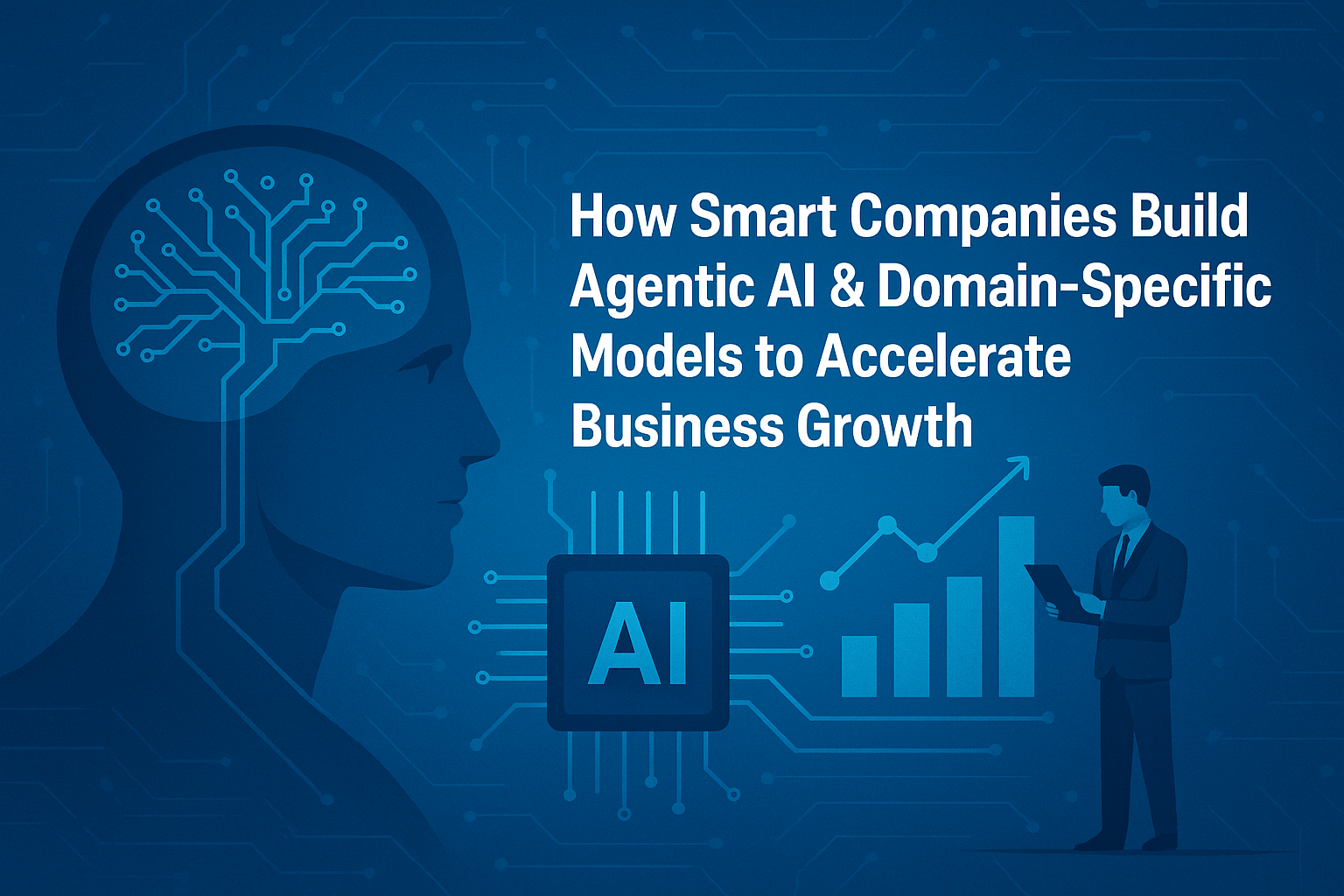
Introduction
Let’s face it—AI is no longer just a buzzword; it’s becoming the core of modern business strategies. But here’s the kicker: generic AI tools are no longer enough. Today’s innovative companies are building Agentic AI systems and domain-specific models to truly transform operations, speed up decision-making, and stay ahead of the curve.
So, what’s Agentic AI all about? And how do domain-specific models fit into the picture? Let’s break it down step by step and see how forward-thinking organizations are leveraging these powerful tools for explosive growth.
Understanding Agentic AI
Definition and Core Principles
Agentic AI refers to systems that don’t just respond to commands—they take initiative, make decisions, and act on behalf of users or businesses. Think of them as AI “agents” with autonomy, goals, and reasoning capabilities.
Key principles:
-
Autonomy: Can operate without constant human oversight.
-
Goal-oriented: Designed to achieve specific outcomes.
-
Context-aware: Adapts based on the environment and new inputs.
Agentic vs. Traditional AI
Traditional AI is reactive. It follows instructions. But Agentic AI? It thinks a step ahead. For example, while a traditional chatbot might answer your questions, an AI agent can schedule appointments, follow up on issues, and even notify stakeholders proactively.
Real-world Examples of Agentic AI in Action
-
Salesforce Einstein GPT: Not only suggests actions but also takes them based on CRM data.
-
AI Assistants in IT: Identify system failures and autonomously trigger recovery processes.
-
E-commerce Bots: Manage inventory, forecast demand, and re-order products automatically.
The Role of Domain-Specific Models
What Are Domain-Specific AI Models?
Unlike general-purpose models like GPT-4 or Gemini, domain-specific models are trained on industry-specific data and terminology. They’re fine-tuned to understand nuances that general models simply don’t get.
Examples of Domain-Specific Use Cases
-
Legal AI trained on court rulings and contracts.
-
Medical AI trained on radiology reports and diagnostics.
-
Financial AI trained on trading data, reports, and regulations.
Benefits Over General-Purpose Models
-
Accuracy: Less likely to hallucinate or misinterpret context.
-
Relevance: Offers answers tailored to the domain.
-
Efficiency: Faster inference and leaner performance due to specialized training.
How Businesses Are Using Agentic AI
AI Agents in Customer Service
Imagine a customer support AI that doesn’t just resolve tickets—it escalates urgent issues, updates CRM records, and follows up with customers. That’s the power of agentic design.
AI Agents in Product Development
Companies like Adobe are integrating AI agents to track user feedback, analyze usage patterns, and suggest design changes in real time.
AI Agents in Operations and Logistics
In logistics, AI agents route shipments, detect delays, and optimize delivery schedules automatically—saving hours of manual planning.
Building Blocks of Agentic and Domain-Specific AI
Data Strategy and Curation
Data is the lifeblood of AI. For agentic and domain-specific models, you need clean, relevant, and annotated datasets. This often means:
-
Mining internal documents
-
Structuring unstructured data
-
Creating labeled datasets
Model Fine-tuning and Transfer Learning
Instead of building from scratch, companies use transfer learning—starting with a general model and fine-tuning it using their own domain data. This drastically cuts down cost and time.
Continuous Learning and Feedback Loops
Smart companies set up feedback loops where user interactions are fed back into the model—improving accuracy and performance over time.
Tech Stack for Building Agentic AI
Foundation Models and APIs
Start with foundational models like GPT-4, Claude, or Mistral. Access them via APIs and customize for your use case.
Orchestration Tools
Tools like LangChain, AutoGen, and CrewAI help stitch together multiple AI components into coherent, goal-driven agents.
Cloud and On-prem Infrastructure
Depending on sensitivity, you might run models on:
-
Cloud platforms (AWS, Azure, GCP)
-
On-premise servers for compliance-heavy industries
Key Challenges and How to Overcome Them
Data Privacy and Security
When your model handles sensitive data, you need strong encryption, anonymization, and compliance with GDPR, HIPAA, etc.
Model Bias and Explainability
Bias creeps in from training data. Use explainable AI (XAI) techniques to audit and monitor decisions made by your models.
Skill Gaps and Talent Acquisition
Hire AI engineers, but also upskill your existing teams. Use low-code/no-code platforms to democratize AI adoption.
Future of Agentic AI and Domain-Specific Models
Autonomous Agents That Learn
Tomorrow’s agents will evolve like humans—learning from each interaction, becoming smarter, and more autonomous.
Vertical AI Platforms
Expect platforms tailored for specific industries—think of them as the “Shopify for legal AI” or “Salesforce for healthcare AI.”
AI-Augmented Decision Making
Leaders won’t rely solely on intuition anymore. Agentic AI will serve as an advisory system—offering insights, risk assessments, and projections in real time.
Case Studies
Agentic AI in Healthcare
A hospital uses AI agents to triage patients, schedule appointments, and analyze symptoms—reducing wait times by 40%.
Domain-Specific AI in Finance
A bank fine-tunes a model on regulatory frameworks to assist in compliance audits—saving 1,000+ hours of manual work yearly.
Retail Industry Leveraging AI Agents
Retailers deploy AI agents to manage customer loyalty programs, track purchases, and auto-apply discounts—boosting retention by 30%.
Best Practices for Implementation
Start Small, Scale Fast
Begin with a pilot in one department. Once proven, scale across teams.
Cross-functional Teams
Bring together developers, domain experts, and business leaders to align goals and execution.
Iterative Testing and Deployment
Adopt an agile mindset. Test, learn, and improve with every iteration.
Conclusion
Agentic AI and domain-specific models are no longer futuristic concepts—they’re here, reshaping how businesses operate and grow. From automation to innovation, these technologies empower organizations to act smarter, faster, and more efficiently.
By building your own tailored AI agents and fine-tuned models, you don’t just keep up—you leap ahead. So, what are you waiting for? It’s time to move beyond generic tools and create solutions that truly fit your business DNA.
FAQs
1. What industries benefit the most from Agentic AI?
Industries like healthcare, finance, retail, logistics, and legal services are seeing massive gains from AI agents due to high complexity and repetitive tasks.
2. How is Agentic AI different from automation?
Automation follows rules; Agentic AI makes informed decisions and adapts to new situations, offering dynamic, proactive solutions.
3. Can small businesses implement domain-specific AI?
Absolutely. With open-source models, cloud platforms, and APIs, even small teams can build tailored solutions without breaking the bank.
4. How do I start building my own AI agent?
Start by identifying a high-impact use case. Then, use orchestration tools and foundation models to create a prototype. Scale from there.
5. What skills are needed to manage these systems?
A mix of data science, ML engineering, prompt engineering, and domain expertise is ideal. But with low-code platforms, you can get started even with limited technical skills.

